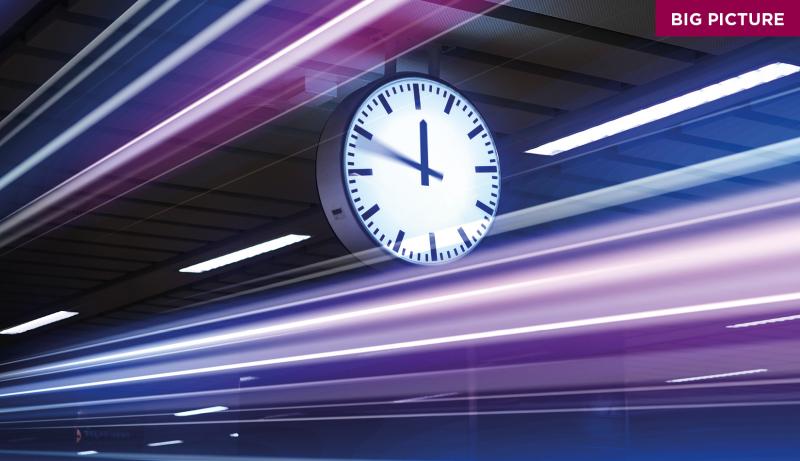
The recent ACT Treasury Forum hosted a discussion on future trends. The four panellists – Paolo Sala, Jack Swait, Ikaros Matsoukas and Arunav Das – take a look at what lies ahead

The role of corporate treasurers has significantly changed over time as a result of super-fast technological developments and the ever-changing underlying macro and micro landscape in which we operate. Here’s a quick reminder of some macro highlights over the past couple of decades:
2000: Dotcom boom and bust
2008: The global financial crisis with government interventions to avoid the collapse of the financial systems. The consequent financial crises in Portugal, Italy, Ireland, Greece and Spain in the following years
2016: Brexit referendum
2020: COVID-19
2022: Russian invasion of Ukraine
2023: Threat of global recession amid double-digit inflation
Ongoing: The new age of sustainability and ESG in response to climate and social crises.
The ability of corporate treasurers to anticipate, manage and mitigate the impacts of economic and political developments, as well as to be ready to quickly and flexibly respond to the unplanned, will always be key factor for the success of the organisations for which we work.
Likewise, the ability to select relevant and resilient technological counterparties that can help the job of the treasurer are, more than ever, key recipes for success. This is particularly true because technology is the enabler that allows treasurers to deliver more and better with fewer resources.
With the fast-moving pace in this sector, we have seen a lot of tech organisations come and go. Therefore, we need to make sure that the tech company we invest in today will be there in the near future to support our current needs as well as our future needs, which we know are going to be different.
If you work for an organisation that puts customers first, you will need to respond to ever-changing customer demands to be relevant today and tomorrow. One of the relatively recent mega-trends we have seen is the digitisation of payments and receivables. Being able to engage with your customers globally through all channels – enabling a quick and frictionless check out in-person and/or online by offering them their preferred payment methods – is essential in modern economies.
Paying your global suppliers – out of different jurisdictions – with their required payment methods, complying with local regulatory requirements and with the required internal controls, workflow and encryption, could be a challenge as financial institutions are lagging behind fintech companies that have been able to take advantage of opportunities to provide better services.
Here is where the treasurer can, and will, play a key role in the future because of our genuine desire to drive automation with best-in-class treasury solutions, and to respond quickly to the needs of customers and suppliers. This must take into consideration the impacts of treasury projects in terms of internal IT infrastructure, financial and legal frameworks, back-office processes, internal controls, tax, ESG aspects and, last but not least, costs for our organisations.
The solution must be a win-win for all parties involved. This is stretching far beyond the traditional treasury remit as it requires a higher level of technical understanding in addition to a much higher level of internal engagement and cross-functional collaboration.
So, while on one hand the role of corporate treasurers will carry managing micro- and macro-economic, financial and non-financial risks, on the other, it will be fundamental to keep a close eye on the technological developments to drive simplifications with cross-functional win-win opportunities for the collective and best treasury solutions.

As corporate treasurers pursue transformation projects, they look to their partners, including cash management and technology providers, to support them in navigating the journey. Establishing centralised real-time models with accelerated movement of funds remains high on corporates’ agenda. Many treasurers are seeking the ability to consume large volumes of data from their cash management providers in real time and all on globally deployed technology platforms, as well as with streamlined processes and fewer accounts.
Banks have responded to this demand with a range of solutions. Real-time payments, APIs and virtual accounts provide more arrows in a treasurer’s already bulging quiver to accelerate and streamline treasury processes. This trend is especially evident in light of the proliferation of new business models requiring digital solutions, including real-time receipt of account information, domestic and cross-border disbursement, and automated receivables reconciliation.
The knock-on effects of this development are evident in the diversification of collection methods. The race has now begun among corporates to offer their customers the experience they increasingly expect. The most innovative corporates are aware that it is a material competitive advantage that could be critical to survival. The need to offer customers the payment journey they demand is made more challenging since new payment methods are not replacing legacy ones but joining them on the list that discerning consumers expect.
This is creating challenges for cash management and treasury teams not only to integrate diverse collection methods into their front-end point of sale (POS) and e-commerce checkouts but also to reconcile increasingly eclectic reporting that often accompanies each receivables instrument. While corporates continue to redefine the art of the possible by employing the latest solutions in ever more sophisticated ways, new possibilities continue to emerge on the horizon with data, distributed ledger technology (DLT) and APIs all showing promise.
Increasingly, central banks are exploring the idea of their own digital currency, a CBDC that could ensure safety, robustness and efficiency of payments for developed nations while promoting financial inclusion in emerging economies. CBDCs could help to spur further economic growth by making payments and settlements more efficient and cheaper.
As one of the world’s largest financial institutions, with deep experience of cross-border payments and foreign exchange markets, HSBC will continue to be involved in discussing and developing CBDCs. We are already working in partnership with many central banks, including those in the UK, France, Canada, Singapore, mainland China, Hong Kong, Thailand and the UAE, as they each consider how CBDCs can best work for them.
This is a rapidly evolving space in which it is important to stay connected with developments. It’s therefore important to engage with banking and financial partners, other functions within the company, including those with direct customer contact, and treasury peers.

The combination of the new macro environment with a number of technologies becoming more available or more mature has created a unique situation. We are seeing new ideas piquing the interest of corporate treasurers together with more established concepts re-emerging as post-COVID trends.
We see new business models, the exponential growth of e-commerce and the direct-to-consumer trend, supported by advances in payments technology (APIs, digital payments) and the establishment of industry standards and regulations (Open Banking, PSD2, ISO 20022). We also see financial risk management re-emerging with more and more companies exploring – and in fact prioritising – the review of their currency or interest rate risk management policies and seeking advice on how these should look like in a more volatile economic landscape.
It is worth noting that all of the above have sustained a more foundational trend that we have been experiencing: we see technology stepping in at the forefront, becoming the spearhead of treasury transformation.
Ten or 15 years ago, at the start of my career in finance, technology was more of an afterthought, something that we’d come to implement after all new business processes and policies had been agreed and signed-off. What we see now is technology being an integral part of this discussion. The reason is that more organisations are starting to realise that it is technology that offers those building blocks to design and execute their strategies, and help them stay competitive.
The 2022 shocks, with the increased geopolitical risk adding to existing supply chain challenges and market volatility, showed us again the importance of being resilient. Although resilience is not a new imperative for business, what has now changed is the speed and the severity with which these new challenges become the new paradigm. On a more positive note – at least for the business – corporates have access to a variety of tools and to vast amounts of data to help them be more prepared and resilient.
As a result of that, we see cash and liquidity forecasting processes being revisited, and a more dynamic, scenario-based planning approach emerging that leverages AI and machine-learning tools.
Some real-time processes and tools have been available to treasurers for a long time. Again, I remember 10 or 15 years ago we were being asked to connect real-time data feeds (Bloomberg) to treasury management systems. Our response was very similar to our response now: “Do you really need it? Would a real-time GBP/USD feed bring any value,
especially considering the high cost and technical debt?”
Of course, the current ecosystem is more mature in terms of supporting a real-time infrastructure, but we still encourage our clients to reflect on what would a move towards real time mean to them and to their working capital. Would it generate more value, decrease costs or meet any other business objective? The answer could be yes, if, for example, instant balance reporting is paramount to the business, but in other areas – such as payments – the answer might be that an in-time or on-time model is a wiser, more fit-for-purpose choice.
Looking ahead, we should expect to see greater disruption, and to come across things we now don’t know that we don’t know. Look at what 2022 brought to art. Text-to-image generators using AI such as DALL-E and MidJourney allowed everyone to create art not just without brush and paint, but even without any specialised software. Just with a text prompt.
Now, if AI can do that to art – the human activity we considered perhaps to be the least susceptible to disruption – imagine what it can do to treasury and finance. But we can see this with optimism: AI upended the ways of making art. It did not reduce the human need for artistic expression – if anything, it further enabled it. The same can happen to treasury – or the art of it: the need to manage liquidity in an efficient way, to safeguard our organisations from risk and so on, will still be there. It will be the ways of performing these processes that will be disrupted.

The corporate treasury construct is evolving to support the transition from pre-pandemic ‘just-in-time’ to post-lockdown ‘just-in-case’ business models. The latter involves designing treasuries to accommodate reconfiguration of supply chains and distribution centres in a rapid, dynamic and digital way.
Such a shift of business models at short notice presents new challenges with liquidity and FX risk managements. In addition, the current interest rate environment has already posed interest rate risk management challenges on both sides of the balance sheet because of a trade-off between working capital financing costs and opportunity cost for foregoing investment of surplus cash.
Treasuries have invested in the automation agenda for more than three decades and the majority of the investments made have been geared towards bringing operational efficiencies linked to Accounts Payable and Accounts Receivable centres. This is an important foundation for setting up a real-time digital treasury.
The journey for setting up a digital real-time treasury would involve:
Digital real-time treasury models with well-designed and integrated consolidation, forecasting and decision support systems would also be able to find new opportunities for creating efficiencies in the business through assessment of bank account structures, automated reconciliation, self-served queries, with better management of cashflows and credit decisions.
This article was taken from Issue 2, 2023 of The Treasurer magazine. For more great insights, members can log in to view the full issue. If you're not an ACT member, you can sign up for eAffiliate membership.
